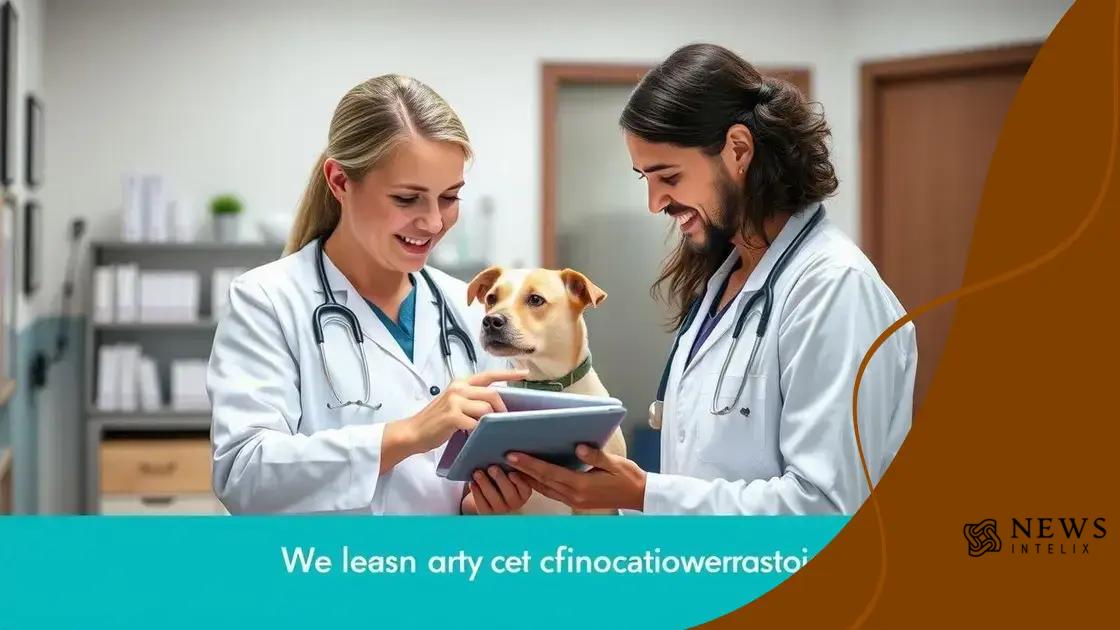Vets get faster services by embracing innovative solutions

Vets get faster services by implementing technology, optimizing workflows, and streamlining appointment scheduling, significantly enhancing client satisfaction and operational efficiency in veterinary practices.
Vets get faster services by utilizing new tools and technologies that improve patient care. Have you considered how these innovations could revolutionize your practice? Let’s explore this exciting evolution.
Understanding the need for speed in veterinary clinics
Understanding the need for speed in veterinary clinics is essential for enhancing patient care and improving overall efficiency. When pet owners seek veterinary services, they expect timely responses and quick resolutions to their needs. The demand for speed is driven by the desire to provide the best care for pets while managing busy schedules.
Why is speed important in veterinary practice?
Speed in veterinary services can significantly affect client satisfaction and business outcomes. Fast service often leads to happier clients and improves retention rates. This urgency is not just about being quick; it’s about providing efficient care without compromising quality.
- Short wait times increase client satisfaction.
- Quick diagnoses lead to timely treatments.
- Improving office workflow can reduce stress for staff.
Moreover, with advancements in technology, clinics can now achieve greater speed without sacrificing care quality. Veterinary clinics that embrace these technologies are poised to meet the needs of modern pet owners who value efficiency. Utilizing tools like online booking systems and telemedicine can shave precious minutes off the service time.
Clients expect faster veterinary services
Pet owners today are looking for quick access to veterinary care. They want answers now. This means that clinics need to adapt to new expectations.
How can clinics improve their speed? First, they can streamline appointment scheduling. Minimizing paperwork and using digital forms can create a smoother experience right from the start. Next, adopting technologies, such as telehealth consultations, can provide quick access to veterinary advice without the need for an in-person visit.
- Adopt digital booking systems for appointments.
- Provide telemedicine options for quick consultations.
- Standardize procedures to reduce delays.
In conclusion, understanding the need for speed in veterinary clinics is about making smart choices that benefit both the clinic staff and pet owners. This not only meets client expectations but sets the foundation for a thriving practice. By focusing on efficiency and leveraging technology, veterinary clinics can enhance their service levels significantly.
Innovative tools that streamline veterinary services
Innovative tools that streamline veterinary services can transform how clinics operate. These advanced technologies not only speed up processes but also improve the quality of care for pets. With the right tools, veterinary staff can focus more on patient care rather than administrative tasks.
Types of innovative tools available
There are numerous tools available that can help veterinary practices enhance their services. These include software solutions for scheduling, record keeping, and even treatment planning. By automating routine tasks, clinics can save time and increase efficiency.
- Practice management software: This allows clinics to manage appointments, billing, and patient records in one place.
- Telemedicine platforms: Veterinarians can consult with clients remotely, providing quicker access to advice and care.
- Digital diagnostic tools: Technologies like digital X-rays and ultrasound machines help speed up diagnosis.
Additionally, mobile applications can keep pet owners engaged and informed about their pets’ health. These resources enable clients to book appointments, access health records, and receive reminders for vaccinations, enhancing client satisfaction and retention.
Benefits of using innovative tools
The integration of these tools into veterinary practices offers significant advantages. For one, they streamline workflows. With less time spent on paperwork, veterinarians can dedicate more energy to their patients. Furthermore, these technologies can reduce errors, ensuring that every pet receives the right treatment at the right time.
Imagine a scenario where a client can book an appointment and access their pet’s medical history through a mobile app. This not only enhances the client experience but also allows staff to prepare for appointments more effectively. Streamlined services ultimately lead to better outcomes for pets and greater peace of mind for pet owners.
- Improved patient outcomes due to faster diagnostics and treatments.
- Enhanced client communication through regular updates and reminders.
- Reduced administrative burden for veterinary staff.
With the ongoing advancement of technology, the future of veterinary care looks bright. Embracing innovative tools is crucial for any clinic looking to stay competitive and meet the growing demands of pet owners.
How technology is reshaping vet-client interactions

How technology is reshaping vet-client interactions is a fascinating trend in the veterinary field. With more pet owners turning to digital solutions, vets must adapt their communication channels to meet these changing demands. This transformation not only enhances client satisfaction but also improves the quality of care pets receive.
New communication tools
Many clinics now use text messaging and mobile apps to keep clients informed about their pets’ health. These tools allow for quick updates on appointments, vaccination reminders, and even test results. Pet owners appreciate the convenience of receiving information directly on their phones, which can lead to better engagement and compliance with care recommendations.
- Telehealth services: Vets can conduct virtual consultations, saving time for both the clinic and the clients.
- Online appointment bookings: Clients can schedule visits at their convenience without waiting for office hours.
- Health portals: Clients have easy access to their pets’ medical records, fostering a transparent care process.
In addition, these advancements allow veterinarians to broaden their reach. With telehealth, a vet can consult with clients and their pets from anywhere. This flexibility is particularly beneficial for pet owners living in remote areas or those with mobility challenges.
Enhancing the overall experience
Technology also enriches the overall experience for both pets and their owners. When clients can access detailed information about their pets’ health, it empowers them to make informed decisions. They feel more connected to their veterinary team, enhancing trust and loyalty.
Moreover, clinics utilizing social media and online platforms can share valuable pet care tips and updates, turning clients into a community. This interaction keeps clients engaged and informed, making them feel like a part of their pet’s care journey.
- Interactive social media posts keep clients engaged with helpful tips.
- Email newsletters can provide updates on new services or health advice.
- Animal care blogs can educate pet owners further.
As technology continues to evolve, the vet-client relationship will only become stronger and more effective. By embracing these innovations, veterinary practices not only streamline their operations but also create a more satisfying and supportive experience for pet owners.
Success stories: Vets getting faster services
Success stories: Vets getting faster services showcase the remarkable changes happening in veterinary practices today. Many clinics have successfully implemented new strategies and technologies, leading to quicker service and improved client satisfaction. These success stories are inspiring examples of how innovation can transform veterinary care.
Case Study: A clinic in action
One veterinary clinic adopted a new practice management software to streamline their scheduling and billing processes. This change allowed them to reduce appointment wait times significantly. Clients began noticing that they could book their pets in for visits more easily and without extensive delays.
- Reduced wait times: Appointments were often scheduled within a day or two instead of weeks.
- Improved client feedback: Clients reported higher satisfaction due to faster service.
- Increased workflow: Staff could manage their time better, leading to a happier work environment.
Another veterinary practice introduced telemedicine services, enabling them to conduct remote consultations. This tool proved invaluable during busy hours, allowing vets to address minor concerns quickly without taking up appointment slots. Clients found this service particularly useful for urgent questions.
Faster services lead to thriving practices
As a result of implementing these changes, many clinics experienced growth in client numbers. The combination of faster services and enhanced communication kept clients coming back. Additionally, these practices noticed improvements in overall team morale, as staff members felt less stressed and more focused on patient care.
Story after story illustrates how investing in technology not only meets client demands but also significantly enhances the overall veterinary experience. For instance, a clinic specializing in emergency care saw drastic improvements in their operation. By adopting a triage system that prioritized urgent cases, they reduced treatment times for critical patients, ultimately saving more lives.
- Enhanced critical care response times.
- Greater patient retention due to positive experiences.
- Increased community trust in the veterinary service provided.
These success stories highlight the potential for veterinarians to innovate and adapt. By embracing faster service strategies and technologies, clinics can elevate their practices, benefiting both pets and their owners.
Practical tips for implementing faster services in your practice
Practical tips for implementing faster services in your practice can lead to significant improvements in client satisfaction and operational efficiency. By adopting a few key strategies, veterinary clinics can streamline their processes and enhance the overall experience for both pets and their owners.
Streamlining appointment scheduling
One of the first steps to speed up services is improving appointment scheduling. Use online booking systems to allow clients to schedule their visits at their convenience. This not only reduces phone calls but also minimizes the time your staff spends on administrative tasks.
- Online booking systems: Make it easy for clients to select available times and book appointments online.
- Automated reminders: Send text or email reminders to reduce no-shows.
- Manage blocks of time: Reserve specific times for certain services to increase efficiency.
Adopting these practices will create a smoother experience for clients and staff alike. When clients can book appointments without hassle, it opens up more time for the veterinary team to focus on care.
Embracing technology
Investing in technology can also transform your practice. Implement tools such as practice management software and telemedicine solutions. These technologies can help speed up administrative processes and patient consultations.
For instance, using a practice management system can automate billing, records management, and scheduling. Telemedicine options allow for quick follow-ups and consultations without the need for an in-person visit.
- Use digital diagnostic tools for faster test results.
- Implement telehealth platforms to offer virtual appointments.
- Utilize mobile apps for client communication and updates.
These changes not only save time but also help in maintaining high-quality care standards. As your team spends less time on administrative tasks, they can concentrate on providing excellent service.
Optimizing workflow
Lastly, optimizing workflow is essential for ensuring that every team member knows their role and responsibilities. Clearly define processes for different tasks and cross-train staff to handle multiple roles.
This flexibility allows the team to adapt to busy periods and ensures that no one aspect of care is neglected. Regular training sessions can keep everyone updated on new tools and procedures, making your practice run efficiently.
- Clarify roles for each staff member.
- Facilitate regular trainings to keep staff updated.
- Encourage teamwork to ensure tasks are completed quickly.
By focusing on these practical tips for implementing faster services, veterinary practices can create a more efficient environment. This ultimately leads to a better experience for clients and their beloved pets.
FAQ – Frequently Asked Questions about Faster Veterinary Services
How can online appointment scheduling help my veterinary practice?
Online appointment scheduling reduces phone traffic and simplifies the booking process, making it more convenient for clients to secure appointments.
What are the benefits of using telemedicine in veterinary care?
Telemedicine allows for quick consultations, saving time for both vets and clients while providing immediate support for minor health issues.
How can I optimize my clinic’s workflow?
Optimizing workflow involves defining clear roles for staff and implementing efficient processes, which can reduce delays and improve service speed.
Why are automated reminders important for my practice?
Automated reminders help decrease no-show rates by keeping clients informed about their upcoming appointments, leading to better scheduling efficiency.
